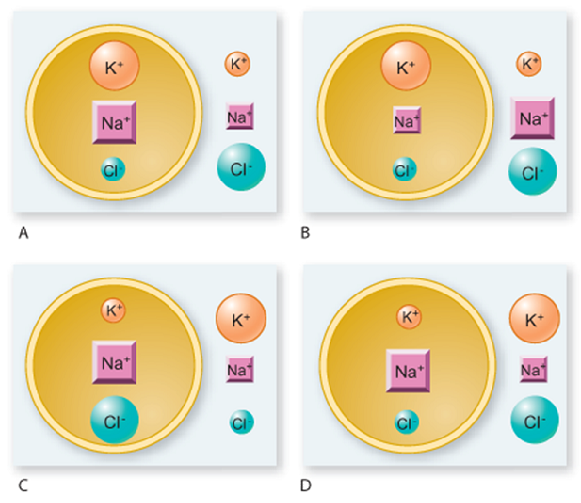Plasmodium, the organism that causes malaria, is a(n)
A) amoeba.
B) stramenopile.
C) ciliate.
D) alveolate.
Answer: D
You might also like to view...
Which diagram correctly illustrates the distribution of ions in a resting neuron? (Note: A larger symbol indicates a higher concentration of that ion.)

A. A
B. B
C. C
D. D
Clarify Question
· What is the key concept addressed by the question?
· What type of thinking is required?
Gather Content/Choose Answer
· What do you already know about ions in cells? What other information is related to the question?
Reflect on Process
· Did your problem-solving process lead you to the correct answer? If not, where did the process break down or lead you astray? How can you revise your approach to produce a more desirable result?
In Atlantic codfish, pressure on the population by commercial fishing caused:
a. the age of sexual maturity to increase b. larger fish sizes to increase c. the size at sexual maturity to increase d. the size at sexual maturity to decrease and the age of sexual maturity to increase e. the size at sexual maturity to decrease and the age of sexual maturity to decrease
Within the endoplasmic reticulum, ________ recognizes misfolded or unassembled proteins and transports them back to the cytosol
Fill in the blank with correct word.
The iron-response element (IRE) is a(n)
A) insulator element that binds IRE-binding protein in the absence of iron. B) transcriptional promoter that directly binds iron to prevent transcription of nearby genes. C) long noncoding RNA that binds iron and regulates transcription of multiple genes. D) sequence in the 5? untranslated region of mRNA that forms a hairpin loop, preventing translation of the mRNA by binding to IRE-binding protein in the absence of iron. E) example of a prokaryotic riboswitch that causes early termination of transcription in the presence of iron.